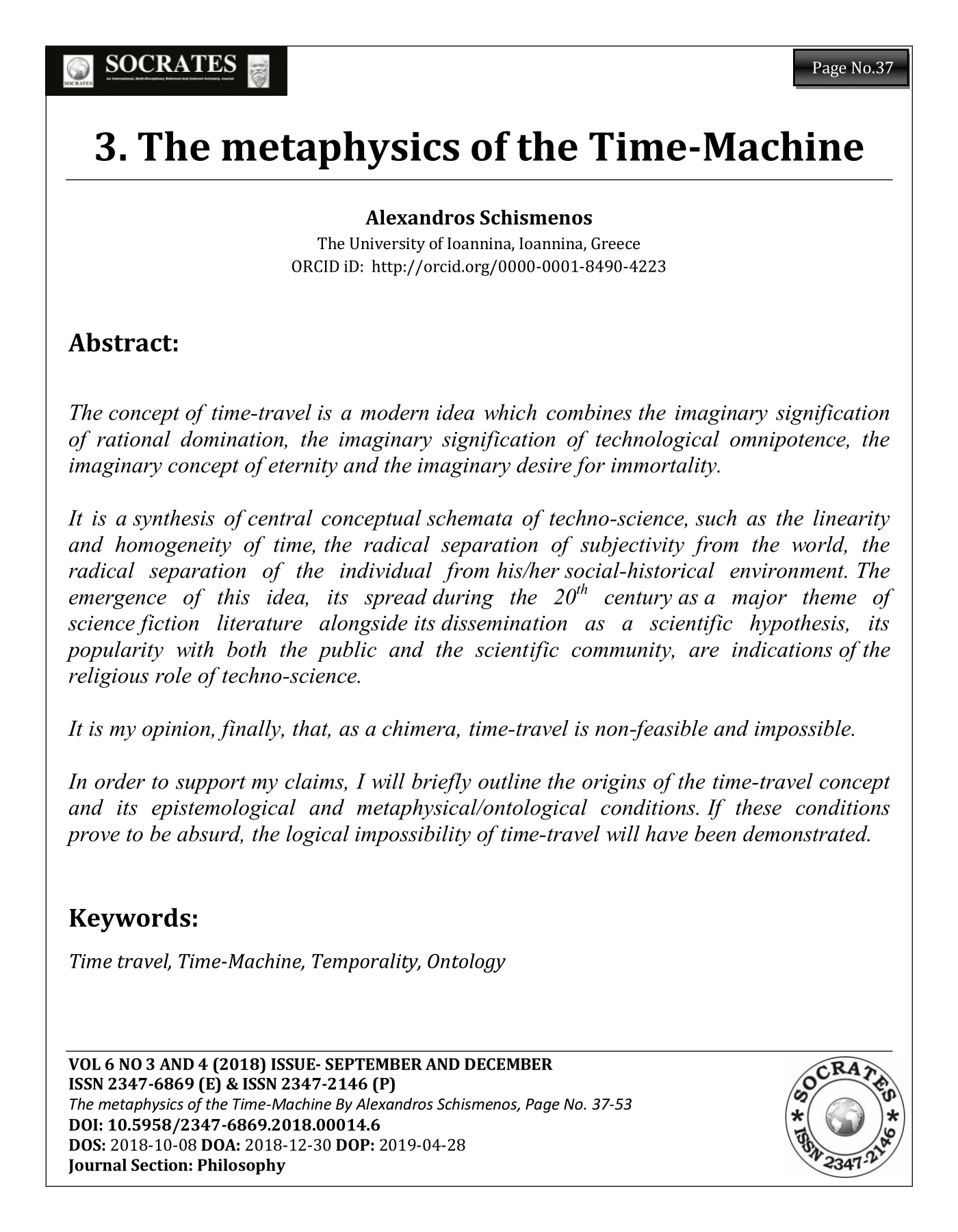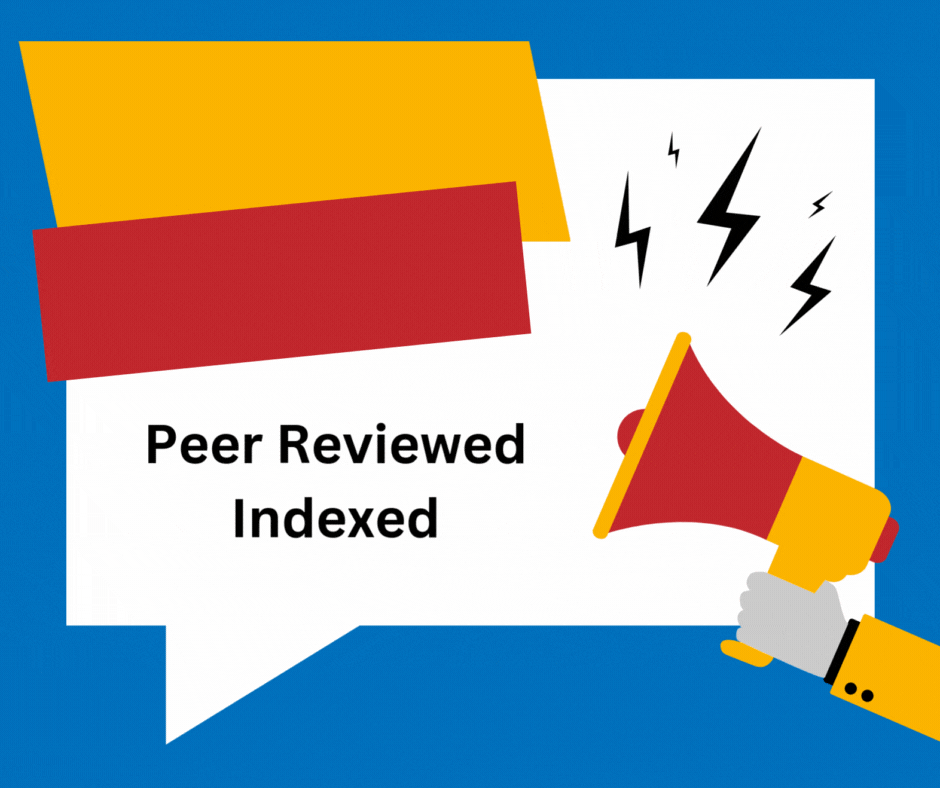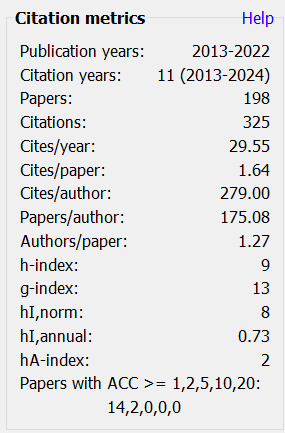The metaphysics of the Time-Machine
DOI:
https://doi.org/10.5958/2347-6869.2018.00014.6Keywords:
Time travel, Time-Machine, Temporality, OntologyAbstract
The concept of time-travel is a modern idea which combines the imaginary signification of rational domination, the imaginary signification of technological omnipotence, the imaginary concept of eternity and the imaginary desire for immortality.
It is a synthesis of central conceptual schemata of techno-science, such as the linearity and homogeneity of time, the radical separation of subjectivity from the world, the radical separation of the individual from his/her social-historical environment. The emergence of this idea, its spread during the 20th century as a major theme of science fiction literature alongside its dissemination as a scientific hypothesis, its popularity with both the public and the scientific community, are indications of the religious role of techno-science.
It is my opinion, finally, that, as a chimera, time-travel is non-feasible and impossible.
In order to support my claims, I will briefly outline the origins of the time-travel concept and its epistemological and metaphysical/ontological conditions. If these conditions prove to be absurd, the logical impossibility of time-travel will have been demonstrated.
DOI: 10.5958/2347-6869.2018.00014.6
Downloads
Metrics
References
Anders, G., & Eatherly, C. (1961). Burning Conscience: The case of the Hiroshima pilot, London: Weidenfeld and Nicholson.
Castoriadis, C. (1997). The Castoriadis Reader, ed. D.A. Curtis, Oxford: Blackwell.
Castoriadis, C. (2008). Fait e à faire. Les Carrefours du labyrinthe, Paris: Points.
DeWitt, B. S. (1970). ‘Quantum Mechanics and Reality’, Physics Today 23 (9): 30-40.
Einstein, A. (1905). ‘On the electrodynamics of moving bodies’, Annalen Phys. 17: 891-921.
Fukuyama, F. (1992). The End of History and the Last Man, New York: Free Press.
Gleick, J. (2017). Time Travel. London: 4th Estate.
Goldin, J. (1988). ‘On Honi the Circle Maker: A demanding prayer’, Studies in Midrash and Related Literature, Philadelphia: Jewish Publication Society.
Hawking, S. W. (1992) ‘Chronology Protection Conjecture’, Physics Review D. 46 (2): 603-611.
Kim, S. W., & Thorne, K. S. (1991) ‘Do vacuum fluctuations prevent the creation of closed timelike curves?’, Physical Review, D. 43 (12): 3929-3947.
Koselleck, R. (2004). Futures Past. New York: Columbia University Press.
Lewis, D. (1976). ‘The Paradoxes of Time Travel’. American Philosophical Quarterly 13 (2): 145-152.
Merleau-Ponty, M. (2002). Phenomenology of Perception, tr. C. Smith, London: Routledge.
Mumford, L. (1967). The myth of the machine I: Technics and Human Development. N. York: Harcourt Brace.
Proust, M. (2000) Time Regained, tr. A. Mayor & T. Kilmartin, London: Vintage Books.
Schismenos, A. (2016). ‘The ontological revolution. On the phenomenology of the Internet. SOCRATES 4 (2): 56-67.
Titor, J. (2001), Original posts retrieved from http://www.johntitor.com/ (last visit, December 28, 2018, 21.07)
Wells, H. G. (1895) The Time Machine, London: Heinemann.

Downloads
Published
How to Cite
Issue
Section
Categories
License
Copyright (c) 2019 Schismenos Alexandros

This work is licensed under a Creative Commons Attribution-NonCommercial 4.0 International License.
Revised Copyright/CC license that applies to all the articles published after 05-02-2017
Attribution-NonCommercial 4.0 International (CC BY-NC 4.0)

Copyright/CC license that applies to all the articles published before 05-02-2017
Attribution-Non Commercial-No Derivatives 4.0 International (CC BY-NC-ND 4.0)

Author(s) will retain all the right except commercial and re-publishing rights. In the case of re-publishing, they will have to obtain written permission from the journal. Additional licensing agreements (Creative Commons licenses) grants rights to readers to copy, distribute, display and perform the work as long as you give the original author(s) credit, they can not use the works for commercial purposes and are not allowed to alter, transform, or build upon the work. For any reuse or distribution, readers and users must make clear to others the license terms of this work. Any of these conditions can be waived if you get permission from the copyright holders. Nothing in this license impairs or restricts the authors’ rights. To view a copy of this license, visit http://creativecommons.org/licenses/by-nc-nd/4.0/ or send a letter to Creative Commons, 171 Second Street, Suite 300, San Francisco, California, 94105, USA.
Research Papers published in SOCRATES are licensed under an Attribution-NonCommercial-NoDerivatives 4.0 International (CC BY-NC-ND 4.0)
















